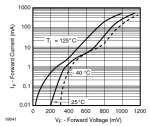Crookedtooth
Member
Hey all! I recently got a Peak DCA55 and have been measuring some things. Here something I am failing to understand...
BAT41s are supposed to have a forward voltage of about 0.38v, yet when I measure with my DCA55 it says the forward voltage is around 0.621v.
Am I missing something? Is the test current different than it needs to be using the DCA55? Is measuring forward voltage better with a multimeter?
I guess my real question is how do I find the forward voltage of my diodes? ?
I’m sure I will ask more questions regarding the DCA55, but for now that is my big one.
Thanks!
BAT41s are supposed to have a forward voltage of about 0.38v, yet when I measure with my DCA55 it says the forward voltage is around 0.621v.
Am I missing something? Is the test current different than it needs to be using the DCA55? Is measuring forward voltage better with a multimeter?
I guess my real question is how do I find the forward voltage of my diodes? ?
I’m sure I will ask more questions regarding the DCA55, but for now that is my big one.
Thanks!




